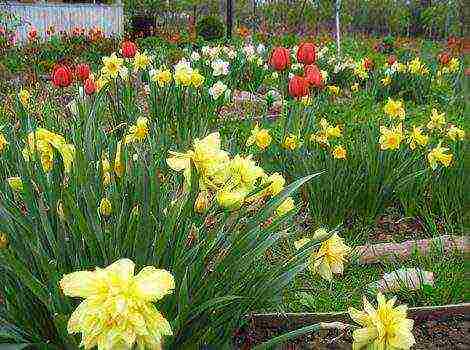Content
- 1 The best dessert grape varieties with a description and a brief description
- 2 Description and brief characteristics of the best technical (wine) grape varieties
- 3 The finest versatile table grape varieties
- 4 Some of the best grape varieties in Russia
- 5 The best grape varieties in Ukraine
- 6 The best grape varieties in Bashkiria and Udmurtia
- 7 Reviews
- 8 Technical varieties for the production of white wines
- 9 Winter-hardy technical grape varieties
- 10 Technical grape varieties for the production of cognac
- 11 The best grape varieties for transportation and storage
- 12 Serious mistakes when choosing technical grape varieties
- 13 Frequently asked Questions
For modern gardeners of the southern and northern regions of our country and neighboring countries, there are no problems with the choice of grape varieties and varieties due to the variety of dessert and technical types of thermophilic culture. A vine with fruits of different shades and sizes, having a unique taste and aroma, with proper care, allows you to experiment on the garden plot and grow adapted grape hybrids, bred in the last decade by Russian and foreign breeders.
The best dessert grape varieties with a description and a brief description
Growing a decent harvest of early-maturing varieties in the Ural vineyards, in Bashkiria or in Siberia and the Far East used to be a wonder, now it is a common phenomenon, spreading even among inexperienced gardeners. In the southern regions of our country and in Ukraine, mid-season and late table and universal varieties of thermophilic culture are successfully grown. Knowing the peculiarities of agricultural technology, amateur gardeners of the Moscow region and St. Petersburg have learned to grow wine grape varieties intended for open ground, rare dessert varieties of grape vines with specific cultivation features. Most often, novice gardeners do not attach importance to the names of hybrids, preferring to work on "white" and "black" grapes. But knowing the names of species and varieties of grapes with white, dark purple and pink fruits, you can easily understand the agricultural technology of culture and adapt to their characteristics.
The best varieties of white dessert grapes
White-fruited table grapes are good both fresh and processed for compotes and jams. New varieties, developed by breeders, make it possible to obtain large, juicy berries of early and mid-season varieties in the southern regions and in the harsh northern ones. A vine with milky white fruits is a natural phenomenon, the result of a mutation of wild-growing grapes that have lost the ability to produce anthocyanins, which are responsible for the dark color of the berries..
To select the best grape varieties, they are judged according to the following criteria:
- yield;
- quality characteristics of fruits (sugar content and acidity);
- resistance to diseases of the vine;
- frost resistance.
Each person has their own preferences. Sometimes large, beautiful berries of modern breeding varieties with a fresh taste may seem unclaimed and ordinary to someone, these gardeners prefer sweet, but small and loose clusters of raisins. For other grape lovers, not only the qualitative characteristics of the berries are important, but also decorativeness, the adaptation of the vine to certain climatic conditions. There are dozens of the newest varieties, which are still difficult to evaluate, but they are already distinguished by high yields and a bright, rich taste of fruits.... For example, Atlantic, a dessert variety with pink, elongated fruits, juicy and aromatic, with floral-fruity notes; nutmeg variety Silver; Alibaba with harmonious berry taste and black-fruited Carmen; an unusual variety Zephyr with raspberry-pink tassels and a Rostov hybrid Anyuta with the aroma of a tea rose and dense pulp.
Photo Gallery: Latest Grape Hybrids
The leading varieties of white-fruited grapes include:
- Arcadia is an early ripe variety, bred in Ukraine (crossing of Moldova and Cardinal), has dense clusters up to 2 kg. A vigorous plant does not suffer from overload and gives an excellent harvest in central Russia and Siberia, the Urals and the Far East. Ripening period 105-115 days. Berries are light green, with dense, juicy pulp, sweet with moderate nutmeg; 2-3 bones are found. Pruning is carried out for 8-12 buds, processed at least 2 times a season from powdery mildew.
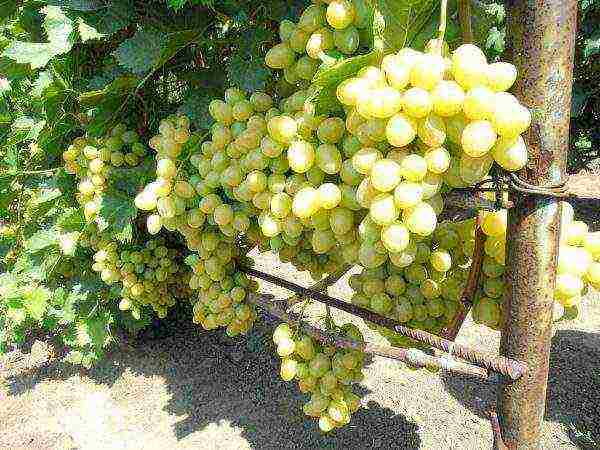
Early ripe grade Arcadia
- Laura (Flora) - a hybrid obtained more than 20 years ago, with light milky oval berries and a pointed tip of the fruit. Crispy, moderately sweet with a pronounced nutmeg aroma. Bunches grow up to 900 g, ripening period - 110-115 days. The medium-sized stem develops well with fan molding, begins to bear fruit for 4 years; trimming for 8-10 eyes. The variety is valued for its frost resistance and for the absence of peeling and cracking of the fruit.

Laura table white grapes
- White kishmish (seedless) is an early ripe variety with round berries, aromatic and juicy. Fruits are light green, in ripeness - with a blush. The bunch is loose, large, weighing from 500 to 1200 g. The berry is loved for its balanced composition of sugar and acids, they are excellent for drying, freezing and do not contain seeds. A medium-sized plant finally ripens at 140–160 days. Requires trimming for 7-10 eyes. The variety is cultivated in central Russia and in the south.
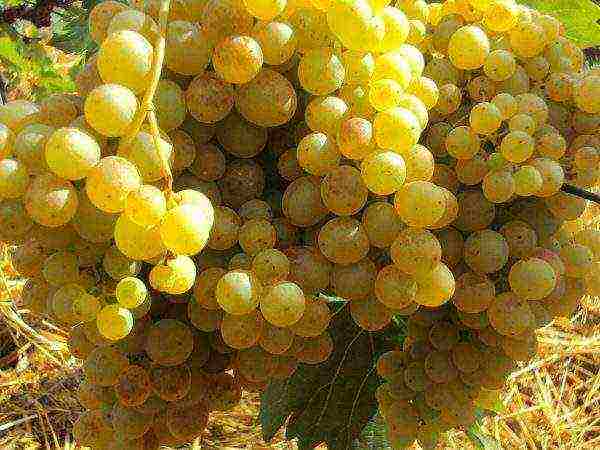
The sweetest white grapes White Kishmish
The varieties of Kishmish include the hybrid variety Volodar (early) with large, dense clusters and yellow-green fruits; and Kishmish 342 (Hungarian), obtained as a result of crossing Vilar Blanc and Sidlis Perlet, is an ultra-early variety with elongated fruits of a milky green shade with a tan, sweet and aromatic. The berries retain their presentation for a long time and do not fall off. Varietal varieties of white-fruited grapes of the subspecies kishmish - Zolotse, Talisman (Kesha), Arsenyevsky are considered no less valuable.
Photo gallery: white fruit varieties of dessert grapes
The variety White CoKl of domestic selection, which appeared in the 21st century, firmly tolerates frosts down to -25 ° C and is not damaged by powdery mildew. Powerful bushes are cut into 10 eyes and try not to overload. Then the large, oblong fruits will be sweet and moderately firm. The weight of grape clusters is from 400 to 700 g.
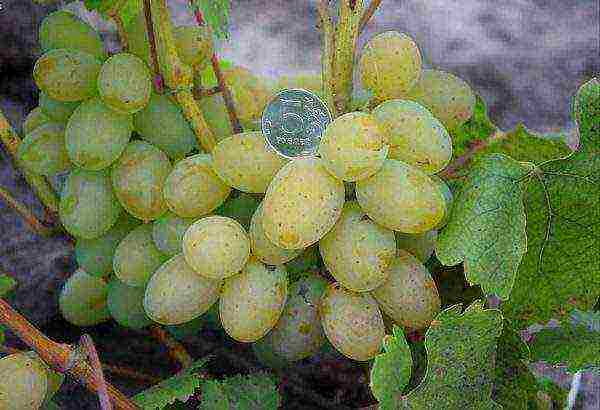
Modern hybrid White Cockle
A hardy and productive variety, Delight quickly takes root and begins to bear fruit in the 4th or 5th year.The early ripening hybrid is thermophilic and responsive to feeding. The result of the gardener's painstaking work will be huge dense clusters weighing 800-1600 g with sweet, large yellow-green berries with a pronounced nutmeg taste. Despite the short pruning, up to 30 kg of the crop is obtained from the bush.
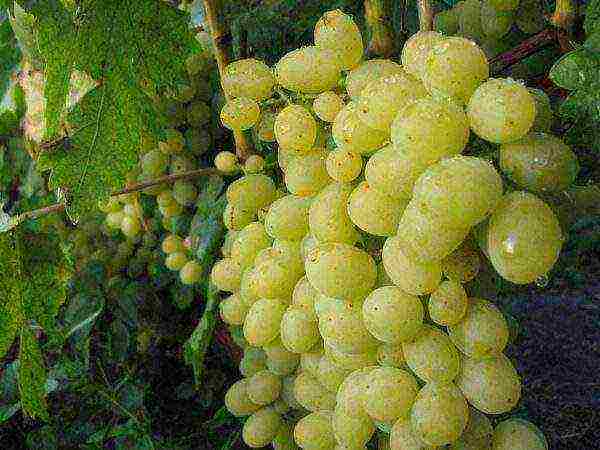
Large-fruited white grapes Delight
In a modern vineyard, Platov's late Jubilee is sure to be met with a harmonious, pleasant taste. For 125–140 days, the bunches grow on average 700 g. The Kostrykin Memory Hybrid became famous for its unpretentiousness and moderate growth of shoots (the vine ripens by 50%). The plant, with a yield of up to 15 kg from one bush, sometimes peas, but is not damaged by wasps and does not require shelter in the middle lane. The average bunch of grapes grows up to 1600 g. Ladies finger with moderate acidity will delight not only with its decorative bunch, but also with delicious fruits. Average weight of brushes - 900 g.
Photo gallery: the best white grapes
The most delicious pink grapes
Hybrid varieties and varieties of pink-fruited vines are attractive in appearance and do not disappoint in taste characteristics. Berries can be from pale pink to deep raspberry shades, so such grapes are often added to wine and canned.
- Early Russian - an unpretentious early ripening variety of dessert grapes ripens at the end of July, loose clusters on average gain up to 600 g. The hybrid grows in the south, the Far East, Bashkiria and Siberia. Light nutmeg with an admixture of caramel aftertaste is loved by every gardener of the middle lane. Rounded, dark pink berries on a tall bush gain sugars - 22%, acids - 7 g / l. 2-3 inflorescences are left on the shoots. The fruit is sometimes cracked and damaged by wasps.

Early Russian grapes grows in many regions of our country
- By crossing Kesha and Rizamat, breeder Kapelyushny bred an ultra-early variety (ripening period of 95 days) Julian, which in less than two decades became popular and fell in love with many growers for its unusual taste and shape. A hybrid with pink, elongated berries, weighing up to 20 g alone, and a powerful vine, grows best in a sunny area; it is cut into 8-10 buds. Juliana's fruits are juicy and moderately sweet, with light fruity notes.

Ultra early grape hybrid Julian
- Tason is an early domestic variety with pale pink, oval medium-sized berries, crispy, juicy pulp, with a delicate fruity-honey aroma; the view was developed by specialists of the VNIIViV named after Ya.I. Potapenko. The hybrid is valued for its yield - up to 35 kg per bush with an average bunch - 800 g. Ripening period - 110-120 days. Pruning vines - 10-12 eyes. Be sure to carry out processing from powdery mildew and mildew.

Delicate Muscat of Tason grapes was appreciated by many gardeners in Russia
- Hybrid Transfiguration - these are uniformly colored pale pink, oval berries with a thin skin and juicy pulp. The variety from Krainov's "troika" (Yubiley Novocherkassky, Victor, Preobrazhenie) is loved for its unpretentiousness and a high degree of adaptation to many climatic features. Therefore, the Transfiguration is grown in the conditions of the Siberian summer and in Bashkiria, where the berry has a more intense crimson color. Bisexual flowers are perfectly pollinated. A vigorous plant with regular feeding gives a stable yield - 1–1.5 kg per bunch of grapes, up to 40 kg of selected fruits are harvested from one plant.
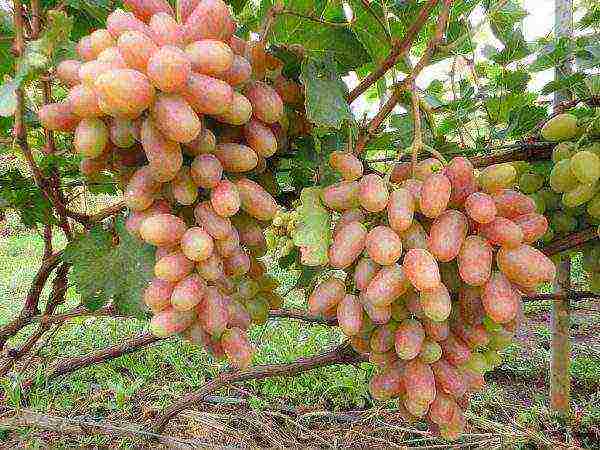
Leader of the "Krainov Troika" - grade Preobrazhenie
- Libya is the brainchild of V.V. Zagorulko, bred in the 90s. The variety is very sweet (sugar content - 26%), aromatic, non-capricious. Peat irrigation and powdery mildew are rare. The berries are oval, pink-purple, with fleshy, nutmeg pulp and thin skin. Ripening period 105 days. The flower is bisexual. Shoots are cut shortly, for 4-6 buds. Among the shortcomings, shedding of ripe fruits and damage by wasps were noted.
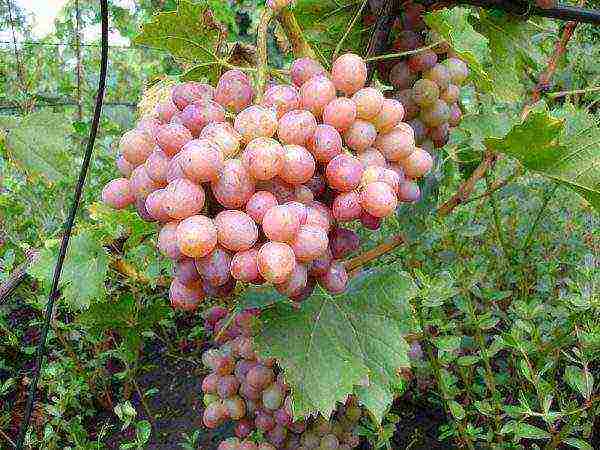
Super early variety Libya
- By crossing Kesha and Rizamat, breeder Kapelyushny bred an ultra-early variety (ripening period of 95 days) Julian, which in less than two decades became popular and fell in love with many growers for its unusual taste and shape. A hybrid with pink, elongated berries, weighing up to 20 g alone, and a powerful vine, grows best in a sunny area; it is cut into 8-10 buds. Juliana's fruits are juicy and moderately sweet, with light fruity notes.
Veles also stands out among the dessert grape varieties.The “parents” of the hybrid are Rusbol and Sofia, amazing in taste and with a stable yield. Veles berries are large, oval, intense pink with a purple tint, the flesh is amber, the skin is moderately dense. There are rudiments in the berries. Veles was appreciated for the muscat-floral aroma of the fruit and the very early ripening period of the first berries - up to 100 days. Vigorous bush, pruning - medium (6-8 buds); sugar content - 23%, acidity - 5 g / l. Covering variety builds up brushes up to 1.8 kg, sometimes more than 2 kg. The fruits are prone to cracking and shedding.
Hybrid Victor from Krainov's "troika" has received attention due to its strong immunity to many diseases of grapes. Winegrowers have long been fond of the berries of the variety, which have an unusual shape and with a bright, nutmeg taste and floral notes. Irregularly colored pink-red finger fruits with juicy pulp ripen 110 days from the beginning of the growing season. The average weight of a bunch is 700 g. The yield reaches 10 kg from one grape bush. To obtain a stable harvest, they practice pruning with 4–6 buds and a moderate load during fruit formation. The main advantages of the hybrid form are high sugar content and transportability.
Asian hybrid Rizamat with finger-like, large (15–20 g), violet-red berries, distinguished by large clusters - from 1 kg to 2.2 kg. Ripening period - 125 days. The heat-loving variety is intended for cultivation in the southern regions, the fruits are moderately sweet, with a light nutmeg; the vine is powerful, pruned into 8-10 buds. Despite the usual taste, Rizamat is loved for its high yield and beautiful grape clusters.
Delicate pink, oval berries of the Gourmet variety in the southern latitudes ripen at the end of July, in the middle lane - at the beginning of August. Author's stamp V.I. Krainova is powerful, branched, with a yield of up to 10–12 kg per plant. When tasting the fruit, fruity notes and a floral-honey aroma are especially noticeable. The grape variety Rumba of the Rostov breeder Kapelyushny is similar to this hybrid, it ripens even earlier than the Gourmet (Red Delight + Cherrel). GF Rumba is very sweet - 23% sugar, with a share of sourness - 6 g / l. Fragrant, juicy berries are perfectly preserved and are not damaged by insects due to the tart, waxy skin.
On a par with these early ripening hybrids in terms of taste, I would like to add V.V. Zagorulko - Sofia, in which the best qualities of two famous varieties are collected - the large-fruited Arkadia and the unforgettable Kishmish radiant nutmeg. Sofia are large, dense clusters (up to 1.5 kg) with pink-purple conical berries, most often they do not contain seeds.
We love Krainov's pink peach breeding for frost resistance and mildew resistance. Flowers are bisexual. The grape clusters of the hybrid are loose, grow up to 1.2 kg, berries with a flavor of nutmeg ripen at the end of August. The variety does not tolerate overload and is picky about feeding. With improper care, the berry becomes smaller and sour, but this does not detract from the advantages of a plant that brings a decent harvest equally in Central Russia, the Urals and Udmurtia.
But also one cannot leave aside the varietal grapes Flamingo pink, similar in shape and taste to Pink peach - with oval, pinkish-red juicy berries and loose clusters up to 1 kg. A hybrid from Moldova requires pruning for 4–6 buds and does not need shelter for the winter (in the south and in central Russia).
Photo gallery: the best pink-fruited grape varieties
Rose-fruited grapes Arched, like the hybrid form of the Original, are similar in fruit size. Arched ripens at the end of August, berries with light nutmeg contain sugars - 18%, acids - 4–5 g / l; juicy, with floral notes. Original grapes - late variety, fruits are rich in sugars - 22%, moderate acidity - 6 g / l. The pulp is watery, but sweet, with a simple taste. These varietal hybrids are practically unaffected by peas. Moderately sweet Aroky is usually used for wine.

Vigorous variety Arochny
The dense grape clusters of the Original variety with conical berries and a bright purple color are stored in a cool room for more than 4–5 months.
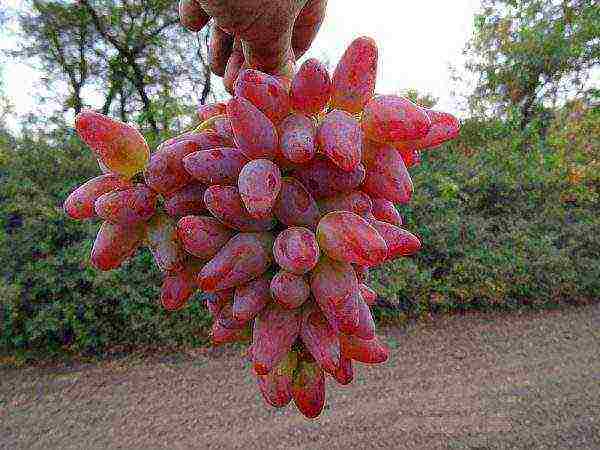
Unusual in shape, tasty and sweet berries of the Original variety are stored for a long time
The best varieties of black dessert grapes
Black-fruited grapes, in comparison with their light-colored "brothers", contain the most monosaccharides and vitamins, are excellent for conservation and winemaking, and seedless varieties are ideal for making raisins and jam. The bright, intense color of the bunches, rich in anthocyanins, serves as a decoration for the garden area.
Most amateur gardeners among dark-fruited grape varieties choose the following modern hybrids.
- Baikonur is an early ripe species - the brainchild of the domestic selection of E.G. Pavlovsky. Dense, voluminous bunches up to 1.2 kg fall on the table at the end of July. The crunchy pulp of dark blue berries with thin nutmeg contains up to 3 seeds, is rich in sugar - 21%. The fruits are able to hang on the bushes for a long time and not crumble. The variety ripens in Udmurtia and Siberia and requires shelter for the winter.

Early ripe Baikonur with blue fruits
- The early variety Codryanka with nutmeg flavor and sweetness is loved by 23% for its abundant fruiting and beautiful clusters. The time-tested variety grows on any soil, provided that the plant is regularly fed, watered and treated against powdery mildew. The weight of the grape clusters is 0.8–1 kg, the berries are dark purple with thin skin. The hybrid is cultivated in most regions of Russia - in the southern regions and in the north, in Transbaikalia and in the Urals.
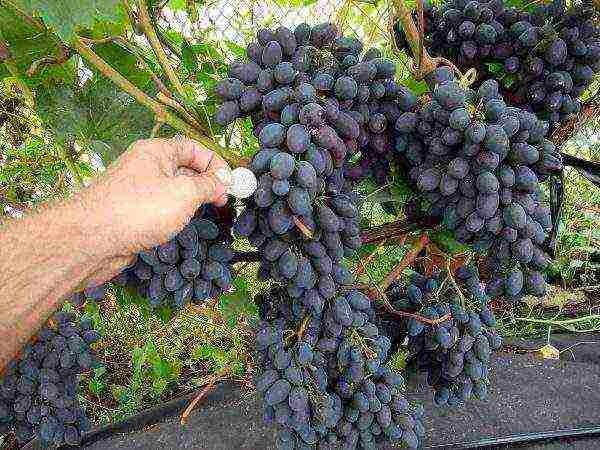
Dark-fruited hybrid Kodryanka
- The unpretentious Russian hybrid Nadezhda Azos (Moldova + Cardinal) is considered the most delicious black grapes. Dark blue, sweet-sour (sugar - 17%, acid - 7%), the fruits are covered with a thin skin, protection from wasps is required. The delicate nutmeg and juicy flesh justify the rare peas of the hybrid plant. The weight of the bunches is 800 g, the ripening period is 125 days. Pruning for 4-6 buds.
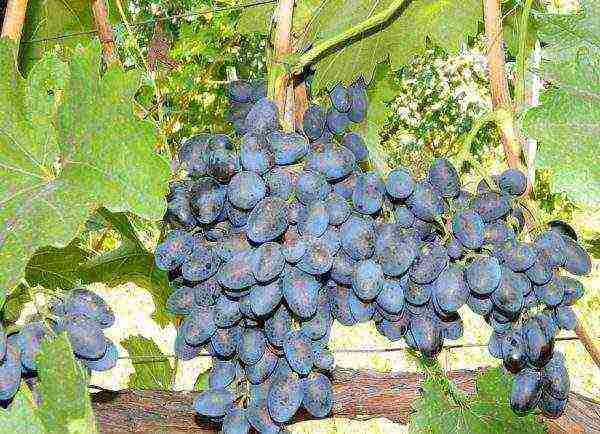
Russian hybrid Nadezhda Azos
- Super early Athos ripens on the 95th day from the beginning of the growing season, the shoots are cut into 7 eyes. A ripe bunch of hybrid forms reaches 1500 g, the variety rarely suffers from insects and powdery mildew. Large blue-black fruits grow on cylindrical bunches, suitable not only for fresh consumption, but also in wines, jams, compotes. The yield of one plant is 15-18 kg.
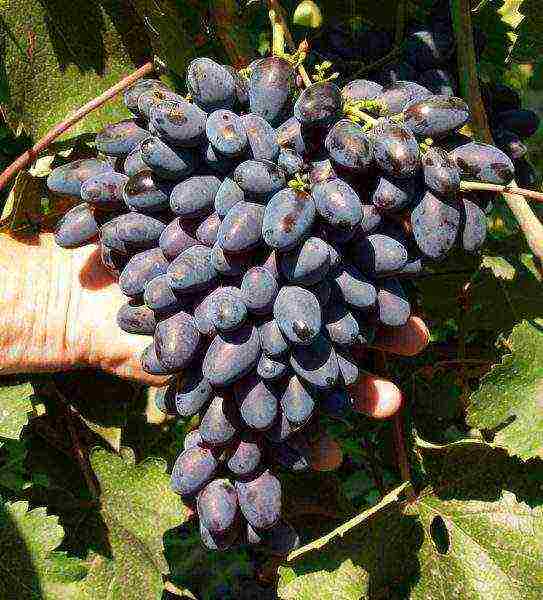
Frost hardy and drought tolerant, Athos
- Surprisingly large, elongated fruit of grapes Odessa souvenir, received in Ukraine. The berries, blue with a black tint, are covered with a waxy coating and contain 4 seeds. The hybrid ripens in early autumn (brush weight - 0.5–0.8 kg). Berries are distinguished by keeping quality, when overexposed on a bush, they do not crumble. Sugar content - 16%, acidity - 6g / l. Flowers are bisexual. Shoots are cut into 8 eyes. Used in winemaking and homemade preparations.

Sweet berries of the Odessa souvenir variety are a little sour and are suitable for making wines and compotes
Among the dark-fruited varieties, some also consider Black Delight (Dolores + Early Russian) the most reliable and productive, which ripens after 110 days. The variety is successfully grown in Siberia and the Far East. A vigorous bush grows on the arches, the brushes are harvested at a weight of 0.6–0.8 g. The Asian variety Black Kishmish (Talisman + Glenora) also earned a high rating among winegrowers. Oval dark blue fruits contain a moderate amount of sugar, they are often used for drying and in compotes. The fruit does not contain seeds. The variety is poorly resistant to mildew infestation. Ekaro 35 is considered the earliest black grape, the berries are purple, round; clusters weigh an average of 400 g. Fruits are rich, sweet, with a specific floral aroma.
Photo gallery: the best black grapes
Black finger is a foreign seedless variety with elongated blue berries with a delicate nutmeg flavor and is appreciated for its impressive fruit size.The heat-loving variety does not tolerate waterlogging, the amount of sugar is 19%, acid is 7 g / l.

Bunch of Hybrid Black Finger
A relatively young American variety Jupiter with an isable taste and pleasant sweetness, they managed to fall in love with their excellent taste (sugar - 21%, acid - 5 g / l), cone-shaped fruits and expressive bunch shape. Trim for 8 eyes. The early ripe hybrid has relatively small (300–500 g) conical clusters. When overripe, the berries soften and lose their taste.

"Overseas" hybrid Jupiter
Black cherry of amateur selection by Vishnevetsky was bred a little over 10 years ago. Among the early varieties, the very first ripens (95–105 days). The weight of the fruit clusters is 400–700 g, the taste is cherry-silk, the flesh is firm and juicy. Berries do not crack, do not crumble; the hybrid is resistant to disease.
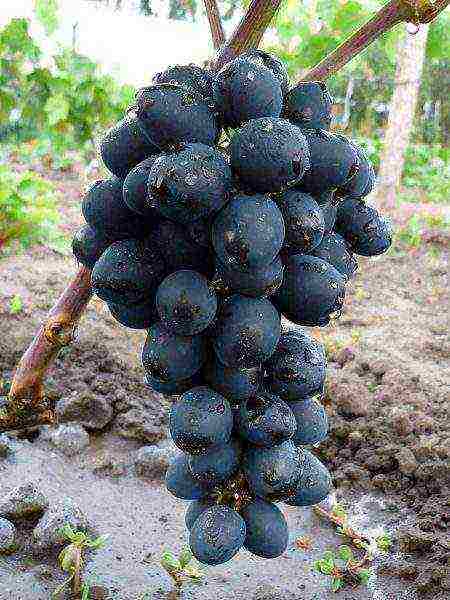
Hybrid Black Cherry
Description and brief characteristics of the best technical (wine) grape varieties
Technical grape varieties, regardless of ripening periods, are raw materials for winemaking... Depending on the intensity of the color and size of the fruit, grapes are used for the preparation of wines and cognac drinks (rose-fruited and black grape varieties more often), for compotes, preserves, jams; for the preparation of raisins, candied fruits, concentrated juices - both white and dark grape varieties.
The most common and widely known table and technical variety is the Isabella grape. Violet-blue, round berries, tightly sitting on a bunch, are distinguished by a high yield - up to 50 kg per bush. Juicy, medium-sized fruits with a specific isable aroma (usually berry-refreshing taste) ripen in 140–160 days. A vigorous bush requires short pruning (5 buds) and a sunny, wind-protected area. In general, the Isabella wine variety is undemanding and resistant to many diseases. 16 -17% - sugar, 5-6 g / l - acid - in the flesh of the Isabella variety. Gives an excellent harvest in Central Russia, the Urals, Udmurtia, Bashkiria.
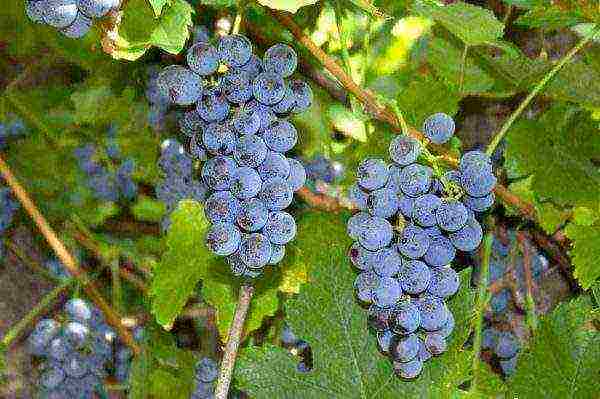
Technical grade Isabella
Another variety intended for winemaking, Vesta, is appreciated for its excellent wintering without shelter and high yields even in cold, damp summers. Sugar content - 25%, acid - 7 g / l. Blue-violet berries form moderately dense clusters, weighing up to 250 g. The juice is not colored, the pulp is juicy. Pruning for 4 buds. The vine is vigorous. The variety is cultivated for making red table wine.
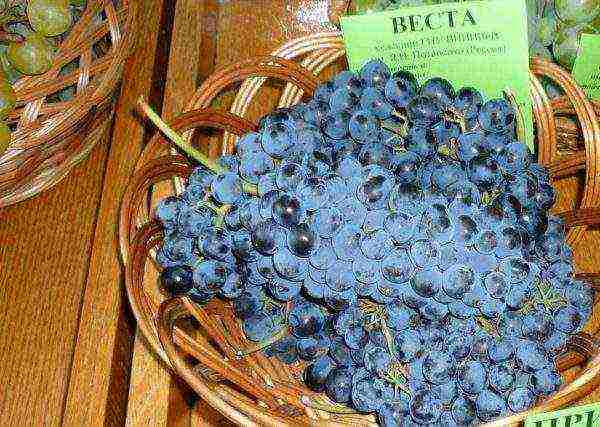
Dense clusters of the Vesta wine variety
Platovsky is a variety of wine and dessert grapes used to make table wines. A hybrid in central Russia and the Far East pleases with an amazing harvest already 115-135 days from the beginning of the growing season. The berries are white with a green tint, round, juicy, small clusters (200 g), very dense. Sugar content - 20%, acidity - 6 g / l. The vine is cut short enough (3-4 eyes), for the winter it is recommended to cover only in the zone of risky agriculture (Siberia, the Far East, the Urals).

White-fruited technical grape variety Platovsky
Late ripening white-fruited variety The firstborn of Magarach forms clusters up to 200 g, is valued for its harmonious, pleasant taste, delicate skin. The berries are white, round, the brushes are elongated, loose. Sugar - 22%, acid - 8 g / l. The wine from Pervenets is light, with light nutmeg and fruity notes. An erect, powerful bush with an openwork crown is not covered for the winter and is often used as an arbor culture.

White-fruited technical grade Firstborn of Magaracha
Table: qualitative characteristics of some technical grape varieties
Photo gallery: varieties of technical grapes
The finest versatile table grape varieties
Lydia is the most common versatile variety, the juicy, sweet fruits of which with a spicy skin are loved by many gardeners. The vine is obtained from seedlings of the wild growing Vitis labrusca. Thanks to its powerful stem and decorative liana, the isabelle variety has spread not only as a table-technical grape, but also as an ornamental culture. Productivity - up to 25-30 kg per bush. An average bunch weighs about 400 g. Overripe berries crumble and rot, a ripe crop (after 150–160 days) is ideal for juices and wines.
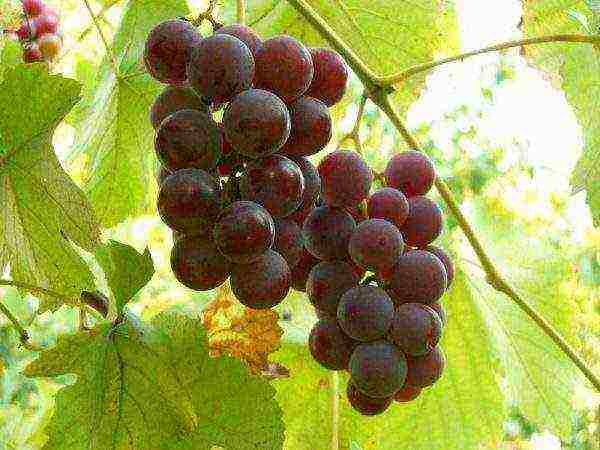
Universal variety Lydia
Hungarian white pearl universal grade suitable for processing and fresh consumption... Amber-yellow, round fruits with subtle nutmeg notes grow on conical clusters. The vine ripens by 80%. Fruit cluster weight - 150-200 g. Pruning - 6-8 buds. Sugar content - 20%, acidity - 7 g / l. A shrub with an average ripening period (120-140 days) is grown in Belarus and Ukraine, in the Urals and Siberia, as well as in central Russia.
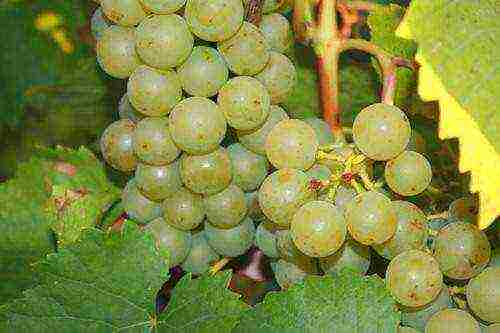
Universal White Pearl
Table-technical grade Black Pearl is a relative of Magarachi, clusters of about 300 g, berries are round, dark blue in color, with sourness and light strawberry nutmeg. Sugar content - 24%, acidity - 6 g / l. Cut grapes for 3-4 eyes, yield in favorable years - up to 15 kg from one bush. A frost-resistant variety of domestic selection was bred in Tula specifically for the production of high-quality dessert wines.

Variety for food and winemaking - Black Pearl
Pink Muscat is a medium-sized table-wine hybrid with bunches of up to 0.2 kg, oval, pink-red berries with a waxy coating. Fruits are fragrant, with floral notes, often used for winemaking, they will be an excellent berry dessert on the table. Average yield - 4-6 kg per bush. The variety is vulnerable to temperature extremes, is affected by powdery mildew and requires fertile soils and fertilizing.

Grape variety Muscat pink
Chassela white, pink and nutmeg is a grape variety that is often referred to as a universal variety. The hybrids are similar in their tasting characteristics, Chassela white (yellow-white, round berries, bunches weighing 190 g) ripens earlier than pink (pink-raspberry fruits with dense skin, brush weight - 250 g); Shasla nutmeg with yellow-green berries has a strawberry flavor, ripens much faster than all varieties of this subspecies. Grapes with sweet, juicy fruits look great on the table and are often highly prized for nutmeg and sugariness when tasting. All types of Chasselas grapes are suitable for wine. Frost-resistant and undemanding grape hybrids are suitable for the zone of risky farming - Moscow region, Petersburg, Bashkiria, Udmurtia, Siberia and the Far East.
Some of the best grape varieties in Russia
There are more than a thousand excellent early, middle and late grape varieties, the purpose of which is the most varied - some are good as a dessert, others for wine and preservation, some table and technical varieties are universal.
Video: the best grape varieties (with a short description)
The best grape varieties for the Moscow region and St. Petersburg
Unstable temperatures, rainy summers in the Moscow region and possible prolonged return frosts - these factors are always taken into account when choosing a grape variety. Therefore, more often in the garden plots near Moscow, early varieties grow - white-fruited Tason, Krasa Severa, Yubiley Novocherkassky, Rusven and the relatively early blue Athos.
In the damp temperate continental climate of St. Petersburg, a fruitful table hybrid in Memory of Dombkovskaya with dark blue fruits, early ripe Laura with large milk-green berries, Aleshenkin, Harold, Libya, Druzhba are safely cultivated.
Resistant to diseases and low temperatures White maxi are distinguished by white-green large berries with sourness and fruity aroma. Of the technical varieties, gardeners near Moscow and St. Petersburg choose the uncompromising variety Lydia.
Video: the best grape varieties for the Moscow region and St. Petersburg
The best grape varieties for growing in Siberia and the Urals
Siberian gardeners practice the cultivation of frost-resistant early-ripening grape varieties - Tason, Timur, white-fruited Tukai; Rochefort, Super extra, White miracle, Cardinal and Codryanka with purple bunches, Delight, White giant are also popular. For winemaking, no doubt, Isobella and Lydia. The berries of Sharov's selection never fail: Sharova's Muscat and Sharov's Riddle.
Photo gallery: grape varieties for cultivation in Siberia
Video: the best grape varieties for the Urals and Siberia
The best grape varieties in Ukraine
The mild, southern climate and long, hot summers allow the cultivation of various varieties of medium, early and late grapes for fresh use, making wine, juices, stewed fruit, candied fruits. Arcadia, Libya, Delight, Julian, Codryanka - ripen in mid-July. Maria Magdalene, Sphinx, Charlie with large dark purple bunches are popular ultra-early varieties; followed by hybrids with light green fruits - Bogatyanovsky, Aramis, Vanyusha, Lancelot, Lyubimy. In early August, the Odessa souvenir, Sigma, Romeo, Strashensky ripen. And at the end of summer, a rich harvest of dessert varieties Zagrava, Sentyabrina, Moldova is harvested; wine hybrids - Rodnichok, Isabella, Alpha.
Photo gallery: the best grape varieties for Ukraine
The best grape varieties in Bashkiria and Udmurtia
The famous hybrids of Sharov, Memory of Dombkovskaya and Korinka Russian are distinguished as the very first for the zone of risky agriculture in Bashkiria and Udmurtia. Super-early and medium-ripening varieties fully ripen and do not suffer from recurrent frosts: Super extra, Alladin, Saratov's Gift, Baikonur, Libya, Monarch. Not uncommon - Radiant Kishmish, Rumba and Early Violet. Working varieties are considered to be fruitful hybrids of Codryanka and Charlie.
Photo gallery: some of the best varieties of Bashkiria and Udmurtia
To prevent the berries from peeling and crumbling in the harsh Bashkir climate, it is imperative to treat the vine with various biostimulants (for example, Gibberellin)
Reviews
Working on new and better varieties, breeders take into account the demand for berry forms and their adaptation rates to different climatic conditions; and the development of winemaking forces amateur gardeners to work on the yield of technical and universal varieties. In any case, the most delicious and harvestable grape hybrids are those that are grown with their own hands on a personal garden plot. If you work tirelessly, even an ordinary universal grape variety will give you berries of amazing taste and aroma that will appeal to any gourmet.
Mena's name is Oksana. Graduated from the MESI branch, faculty of accounting and audit. I love to travel and appreciate the sincerity in people.
Winegrowers claim that the best wines come from technical grape varieties. Since the berries of these varieties contain a large amount of juice. Harvesting of early technical grape varieties begins in early September. The medium ripening varieties are in the middle of September. In the article we will tell you about the best technical grape varieties, give their description and characteristics.
Berries of technical varieties contain up to 95% of the juice of the total weight of the berry.
For the preparation of red wine, raw materials are used from the berries of blue and red technical varieties of grapes. Berries with peels and seeds are suitable for red wine, as they add aroma and astringency. Consider the main varieties for making red wine:
- Cabernet Sauvignon;
- Pinot Noir;
- Sangiovese;
- Syrah;
- Carmenere;
- Grenache.
In the table, we will consider the main characteristics of technical varieties for making red wine:
| Name | Characteristics |
| Cabernet Sauvignon | Ripens from 140 to 160 days. Resistant to mildew and gray mold. Not damaged by phylloxera and leafworm. |
| Pinot Noir | Ripens from 140 to 150 days. Resistant to mildew and gray mold. Not damaged by phylloxera and leafworm. |
| Sangiovese | Ripens from 120 to 130 days. Resistant to a wide range of diseases. |
| Syrah | Ripens from 120 to 130 days. Medium resistance to mildew and powdery mildew. Not damaged by phylloxera and leafworm. |
| Carmenere | Ripens from 130 to 140 days. Relatively resistant to mildew and gray mold. Not damaged by phylloxera and leafworm. |
| Grenache | Ripens from 140 to 160 days. Resistant to mildew and gray mold. Not damaged by phylloxera and leafworm. |
All technical grape varieties for making red wine have a pleasant aroma of fruits and strawberries.
Technical varieties for the production of white wines
For white wines, I use grape varieties whose berries are white or pink. When making wort from such grape varieties, the skin is removed. That is why white wines have a more graceful, soft, delicate taste and aroma. Consider the main types of technical varieties that are used to make white wines:
- Muscat;
- Sauvignon Blanc;
- Pinot Blanc;
- Chenin Blanc;
The geographical location of the vineyards and climatic conditions affect the taste of the wine produced. White wines have a delicate fruity aroma. Read also the article: → "Review of the best non-covering grape varieties for gazebos, trellises, for wine."
White wines last longer due to their high acidity
Winter-hardy technical grape varieties
- Olympic - vigorous late ripening grape variety. The fruits are deeply dark blue. Frost resistance down to -26 ° C.
- Ovidiopolsky - medium-sized grape variety. Abundant fruiting. The berries are light yellow in color, covered with an abundant waxy bloom. Frost resistance down to -25 ° C.
- Allegro - vigorous grape variety. Abundant fruiting. Fruits are black and blue with a waxy coating. Frost resistance down to -27 ° C.
- Sparkle - medium-sized grape variety, with an early ripening period. Fruiting by volume is average. The fruits are white. Frost resistance down to -25 ° C.
- Bianca (Bianca) - medium-sized grape variety, with an early ripening period. Abundant fruiting. The fruits are white with a green tint. Frost resistance down to -27 ° C.
- Johaniter - medium-sized grape variety, with an early ripening period. High yield percentage. The berries are white with a green tint. Frost resistance down to -25 ° C.
- Decent - medium-sized grape variety, with an early ripening period. High yield percentage. The berries are dark blue. Frost resistance down to -25 ° C.
- K-131 - vigorous grape variety, created by breeders when crossing grapes Kabasma, Saba Zhemchug, Amursky. The yield from one grape bush is average. The berries are small, white. Frost resistance down to -27 ° C.
- Crystal - medium-sized grape variety, with an early ripening period. High yield percentage. Berries are yellow-green in color with a white bloom. Frost resistance down to -30 ° C.
- Lada - a vigorous grape variety with an average ripening period. High yield percentage. The berries are dark blue. Frost resistance down to -28 ° C.
The table shows the ripening time and purpose of winter-hardy grape varieties:
| Winter hardy grape varieties | Ripening terms(in days) | Production |
| Olympic | 150-159 | Dessert wine. |
| Odiopolis | 140-145 | White blended wine and juices. |
| Allegro | 141-150 | Rose and red wine, vintage juice. |
| Sparkle | 130-140 | Table white wine and vintage juice. |
| Bianca | 110-120 | Semi-sweet, dessert white wine. |
| Johaniter | 110-120 | Semi-sweet, dessert white wine. |
| Worthy | 120-130 | Dry wine. |
| Outdoor furniture-131 | 110-115 | Semi-sweet, dessert white wine. |
| Crystal | 100-110 | Dry table wine. |
| Lada | 110-115 | Red table wine. |
Tip # 1. The following technical grape varieties with relative frost resistance should not be used for cultivation in regions with cold, snowless winters - Abovyani, 40 years of October, Kukanovsky, Kabasier, Zenith.
According to the leading institutes of viticulture, the above-mentioned frost-resistant grape varieties have different resistance to the most common and dangerous diseases. In the table, we will consider the resistance of each grape variety to a specific type of disease. Explanation of symbols in the table: (B) - high stability; (C) - average resistance; (H) - low resistance:
| Variety | The most dangerous diseases of grapes | |||||
| anthracnose | white rot | mildew | oidium | gray rot | black spot | |
| Olympic | WITH | WITH | WITH | H | H | IN |
| Odiopolis | H | WITH | IN | H | WITH | IN |
| Allegro | WITH | WITH | IN | IN | WITH | WITH |
| Sparkle | WITH | WITH | WITH | IN | WITH | IN |
| Bianca | IN | WITH | WITH | IN | WITH | IN |
| Johaniter | WITH | WITH | IN | IN | IN | WITH |
| Worthy | WITH | IN | H | IN | IN | WITH |
| TO -131 | WITH | WITH | WITH | WITH | WITH | WITH |
| Crystal | WITH | IN | IN | IN | IN | WITH |
| Lada | WITH | IN | WITH | WITH | WITH | H |
The most common grape diseases are mildew, oidium, black spot and anthracnose.
Technical grape varieties for the production of cognac
Cognac is included in the group of alcoholic beverages, the strength of which is at least 40%. This alcoholic drink is made from white table wine with a harmonious taste of Muscat. White table wines, in turn, are made from white and rosé varieties grown in areas with calcareous, stony or clay-calcareous soil. White table grape varieties for cognac are grown on well-moisturized soils, since dry soils prevent the formation of aromatic substances.
When choosing white and pink grape varieties, it is important to take into account the ripening period of a particular variety. Overripe berries or berries that did not have time to collect the required amount of sugar are unsuitable for the production of cognac. The signs of ripeness of white and pink grape varieties are:
- Uniform color of berries: pink for pink varieties; yellow color of berries for white varieties;
- When the berries are crushed, the consistency of the pulp is soft and sticky;
- Seeds darken easily move away from the pulp;
- The skin on the berries is thin, easily separated from the pulp;
- The comb of the bunches becomes dark brown, becomes rough, lignified.
The above signs are subjective. The most accurate method for determining the ripeness of grapes is chemical analysis. The varieties of grapes suitable for the manufacture of cognac include varieties of medium early ripening, with high frost resistance. Read also the article: → "The best early and mid-season grape varieties for the Moscow region."
Consider the traditional grape varieties that are grown in our country:
- Aligote is the best variety for making table white wines. This variety ripens early, around the beginning of September. Resistant to a wide range of diseases, except for mildew diseases;
- Sylvaner is a high-yielding variety that ripens in the first half of September. The berries are light green with brown specks. Does not suffer from drought, frost-resistant, does not require shelter for the winter. Resistant to mildew and powdery mildew.
- Cleret is a medium-yielding variety with an average ripening period of 160 to 170 days (ripens in early October). Berries with a greenish-yellow tint, when fully ripe, the berries acquire a golden hue. The yield is average. High resistance to mildew and powdery mildew. It is not affected by leaf rollers and spider mites. High frost resistance to drought and moisture resistance.
- Swim is a vigorous variety. The yield is average. Ripens in 150-160 days. The berries are white with a greenish tinge. Frost resistance down to -23 ° C. Affected by mildew, moderately resistant to other diseases. Not affected by phylloxera and spider mites.
- Semillon is a medium-sized variety, medium-late ripening period from 130 to 150 days. Berries are golden yellow in color with a waxy bloom. Low frost resistance. It is affected by mildew, oidium and gray rot.
- Kunlean is a vigorous, medium late variety. Ripens in the second half of September. The berries are white. High resistance to diseases and pests. Frost resistance down to -26 ° C.
- Grushevsky white - vigorous, with a late ripening period. Ripens in 145-150 days. The berries are greenish-white. Frost-resistant variety down to -29 ° C. High resistance to diseases and pests. The only drawback is low heat resistance.
Tip # 2. It is not recommended to use isable grape varieties for the production of cognac. The pulp of isabella varieties is distinguished by a viscous and slimy structure. For the preparation of cognac, a must from a transparent and spreading pulp is used.
White grape varieties are left to ripen on the trellis until early October to fully ripen and accumulate the required amount of sugar
The best grape varieties for transportation and storage
Not all technical grades are suitable for long-term storage and long-distance transportation. There are several grape varieties suitable for storage between 20 ° C and 24 ° C and for long distance transportation.
- Samur is a vigorous variety, early ripening period - from 120 to 125 days. The berries are yellow with a greenish tinge.
- Terbash is a vigorous variety, medium late ripening period from 145 to 150 days. Berries are yellow-amber in color with a waxy coating.
- Hamburg Muscat is a medium-sized variety, ripens in 150 days. The berries are blue-violet, covered with a thick waxy bloom.
- Ag-raisins is a medium-sized variety, ripens in 148-150 days. The berries are yellow-green.
- Premier is a medium-sized variety, ripens in 150 days. The berries are white.
- Early Russian is a vigorous variety, ripens from 135 to 140 days. The berries are pink.
An early Russian variety, one of the most winter-hardy varieties
In the table, we will consider the resistance to diseases and winter low temperatures of the above grape varieties:
| Grape varieties | Disease resistance | Frost resistance |
| Samur | Mildew, oidium, gray rot | down to -22 ° C |
| Terbash | White rot, anthracnose, black spot | down to -26 ° C |
| Muscat of Hamburg | — | down to -19 ° C |
| Ag-raisins | Mildew, oidium, gray rot, white rot, anthracnose, black spot. | down to -22 ° C |
| Premier | Mildew, oidium, gray rot | down to -25 ° C |
| Early Russian | Mildew, oidium, gray rot | down to -23 ° C |
Serious mistakes when choosing technical grape varieties
- Cultivars with low disease resistance are selected. These varieties are usually treated with chemicals that affect the quality of the crop.
- For cultivation in cold regions, technical varieties with late ripening are chosen. Berries of such varieties do not have time to ripen and accumulate a sufficient amount of sugar in the berries. Read also the article: → "Description and comparison of new grape varieties for different regions."
- They grow varieties that do not tolerate storage and transportation over long distances.
Frequently asked Questions
Question number 1. What types of technical grape varieties do not tolerate transportation and storage well?
Biruintsa table grape and Pineapple isabella table grape.
Question number 2. How to choose seedlings when buying technical grape varieties?
Seedlings of technical grape varieties are best purchased in special nurseries. To check the quality of the proposed seedling, you can ask the berries of the mother bush for chemical analysis.
Question number 3. How to store technical grape varieties before planting?
There are 2 ways - wrap the seedlings in paper and store them in the refrigerator or in the cellar until planting. The seedlings can be stored in moist vermiculite on the bottom shelf of the refrigerator.
Question number 4. Received grape seedlings by mail, how to store such seedlings before planting?
Seedlings must be soaked in snow water for about a day indoors. After that, pour sand into plastic bags and place the cuttings there. Store the packages with cuttings in the basement.
Rate the quality of the article. We want to be better for you:
Grapes are ideal raw materials for making homemade wine. However, not all varieties of this culture grow well in the middle lane and are suitable for processing.
Technical (wine) grapes are not as beautiful as table grapes. But on the other hand, it is less whimsical, and the berries are distinguished by a high sugar content (19-26%) and a high content of juice (75-88%), which makes them ideal raw materials for winemaking. Wine grapes are also used for the preparation of juices, compotes, soft drinks, etc.
Despite the fact that grapes are a thermophilic crop, good harvests of sweet berries can be harvested even in the middle lane. The main thing is to plant the "correct" varieties on the site, the berries of which will ripen by the end of September.
We offer 5 technical (for wine) grape varieties that are not afraid of cold winters and are excellent for growing in the middle lane.
Alpha is a high-yielding wine grape
This variety is especially popular with winegrowers, because it is high-yielding, is not afraid of pests and is not susceptible to fungal diseases. In addition, it perfectly tolerates frosts down to –22-24 ° С.
The berries are round, medium-sized, black or red-purple in color, covered with a specific waxy bloom.
The flesh of the berries is fleshy, dark green, with a large number of seeds (4-6), the taste is sweet and sour, with a light strawberry tint.
| Appointment | Sugar content (%) | Bunch weight (g) | Berry weight (g) | Ripening period | Trimming (eyes) |
| technical | 15-16 | 100-150 | 1,9-2,2 | end of August | 8-10 |
Kristall is an excellent grape for making dry wine
Super early grape variety. Very productive, has increased frost resistance (up to 29 ° C below zero). Not susceptible to diseases, including gray rot.
What culture fears is drafts. Therefore, it is better to plant it along a high fence or near the southern wall of the house.
The average weight of the bunches is 170-200 g. The berries themselves are also not very large, oval, yellow-green or white with a slight waxy coating.
The pulp is very juicy, acid and sweetness are harmoniously combined in it.
Crystal grapes are ideal for making dry table wines.
| Appointment | Sugar content | Bunch weight (g) | Berry weight (g) | Ripening period | Trimming (eyes) |
| universal | 17-18 | 170-200 | 1,5-2,1 | second half of August - early September | 4-6 |
Platovsky is the ideal grape variety for dessert wine
Differs in high productivity. Bunches of medium size, ripen very quickly (110-115 days after the beginning of the growing season). Not afraid of frost (29 ° C below zero), has an average resistance to diseases and pests.
Rounded white berries with a pinkish tinge are also not distinguished by their outstanding size, but they are very juicy and sweet, with a slight musky aftertaste.
The most delicious table and dessert wines are obtained from Platov grapes.
| Appointment | Sugar content (%) | Bunch weight (g) | Berry weight (g) | Ripening period | Trimming (eyes) |
| technical | 20,2 | 200 | 2 | beginning of September | 3-4 |
Odessa Muscat is one of the most sugary grape varieties
Variety of early middle ripening period (the crop can be harvested 130-140 days after the beginning of the growing season). Disease resistant, tolerates severe frosts well. The yield is average.
The bunches are small. Berries of medium size, yellow-green amber color, with a thin firm skin.
The juicy pulp has a rich nutmeg aroma. That is why Odessa Muscat is ideal for making white table, dessert wines.
| Appointment | Sugar content (%) | Bunch weight (g) | Berry weight (g) | Ripening period | Trimming (eyes) |
| technical | 18,6-22,0 | 130-190 | 1,8-2 | September | 3-4 |
Augusta is an early ripening and fruitful grape variety for wine
The variety attracts winegrowers with its high yield, resistance to frost and disease, as well as early maturity (ripe bunches can be removed already in late August - early September).
The clusters are small and loose. The berries are small, rounded, dark blue, sweet and sour in taste, with a slight musky aroma. Delicious table and dessert wines are made from this grape variety.
| Appointment | Sugar content (%) | Bunch weight (g) | Berry weight (g) | Ripening period | Trimming (eyes) |
| technical | 23 | 120 | 1,3 | End of August - beginning of September | 3-4 |
There are many other grape varieties that grow well in the middle lane and are used as raw materials for making aromatic homemade wine. Having decided to plant one of them on your site, be sure to clarify the data on the timing of its maturation and resistance to major diseases.
Good harvests of grapes and aromatic homemade wine!

